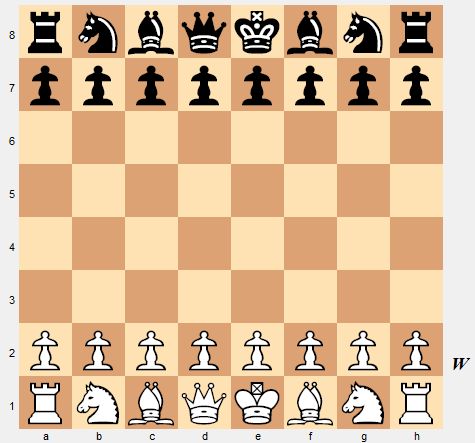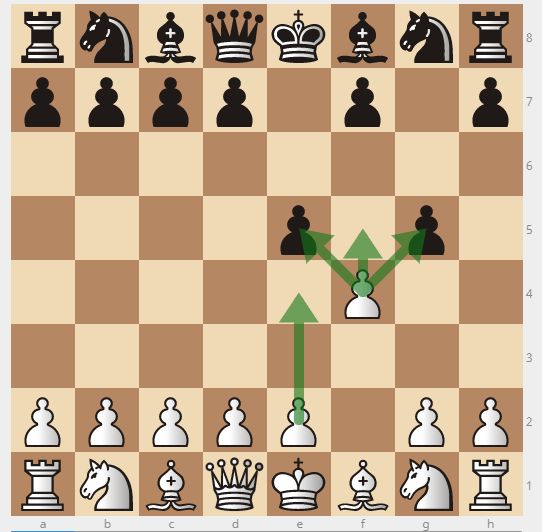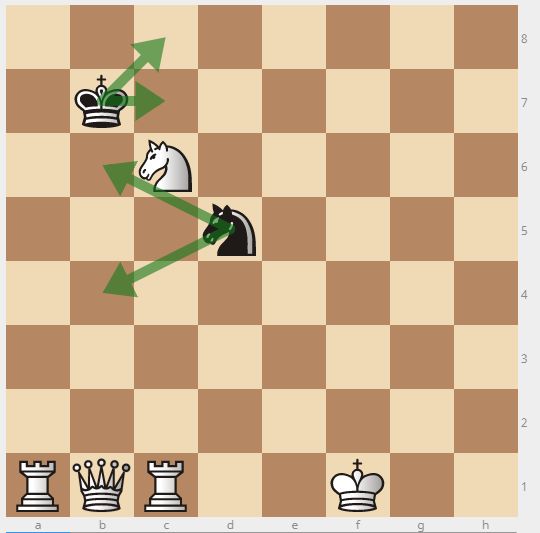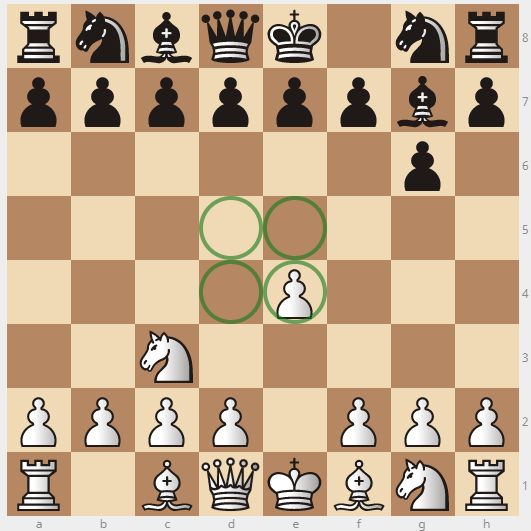|
Welcome, team white! The players are: alcharagia AlphaKretin Artelier CascadeBeta chitoryu12 Decoy Badger Epicmissingno Faerie Fortune LambdaZero M.c.P MagusofStars The Mighty Moltres Yorkshire Tea Rules: The teams will choose their move based on a simple vote - Note that this means that explaining to your team mates why your suggested move is the best is just as important as coming up with it in the first place! Teams will have 24 hours to decide on their move, though I will call the vote early if one move gains a clear majority. (I will generally allow for longer voting times than I did in the previous game however) Please use long algebraic notation for your moves. I'd also prefer if as much team communication as possible is kept in the threads, both for the benefit of the observer thread and to make it easier for new players to follow the lines of thinking without having to use external sites. Lichess links are good though. Players aren't allowed to read the observer thread or the opposing team's thread, observers aren't allowed to post in the team threads. No use of chess engines to find moves is allowed, this includes playing either side of the position against the computer. To ensure that both teams have an equal playing field, the only allowed sources for openings etcetera are Wikipedia and chess.com. However, reading up on standard openings is encouraged as a good way to learn. Absolutely no super villainy allowed. Regarding mentors: The mentors who will be posting in the thread are idhrendur, oldskool and Dr. Fetus. Please add a  to the beginning of any posts in the team threads to separate you from players. to the beginning of any posts in the team threads to separate you from players.The mentors and myself will be available in the team threads to answer any questions and provide advice. To start off with, I will consider any questions that are not asking for specific move suggestions fair game. All post by mentors that are longer than simple "yes" or "no" answers should be crossposted to both threads. If mentors consider any questions a grey area, just check with me via pm or on Discord. Want more chess? If this thread doesn't provide enough chess in your life, I highly recommend you check out the free app Chess by Post! (Microsoft Store , Google Play, App Store) It features both ranked matchmade games against random players at the same skill level, and unranked games with friends with full compatibility across all devices. It also has a very handy move planner, which probably is the main thing saving me from constantly blundering. It also has an extremely merciful time limit for games, which is nice. Usernames of thread goons using the app (just let me know if you want to be added to this list!): covski idhrendur excloudygh circlmastr fatsamurai HisMajestyBOB Livewire42 Leylite Raldan CascadeBeta oath2order TheMightyMoltres schnibs herpicle alphakretin cxp moooo566 Covski fucked around with this message at 19:38 on Sep 20, 2017 |
|
|
|

|
| # ? May 3, 2024 05:45 |
|
Covski posted:Basics of chess: The pieces Covski posted:Algebraic notation Covski posted:Basic opening ideas: Covski fucked around with this message at 16:13 on Sep 11, 2017 |
|
|
|
 You have 24 hours to decide on a move.
|
|
|
|
Lets do this thing! (I'll reserve actually voting until i wake up tomorrow, it's late here.)
|
|
|
|
I'm not too familiar with chess openings but have read up a little on the Wiki, and I think moving e2-e4 is a pretty common and strong move. Our pawn hits the centre of the board, and it opens up our bishop and our Queen.  Assuming we take this line of play, our next move is based on how black responds, but a lot of the common possible moves are documented in the Wiki I linked above. It has got lots of names and jargon but I think I'm following along the logic well enough by looking at the board states and paragraphs that explain why the game flows the way they do. As for why I thought we should start with this particular move, well, it's an established opening. Its strengths seem pretty apparent, and it seems aggressive. We got the first turn, let's pressure Black as hard as we can.
|
|
|
|
Artelier posted:I'm not too familiar with chess openings but have read up a little on the Wiki, and I think moving e2-e4 is a pretty common and strong move.
|
|
|
|
 Welcome to team white! I'll be checking in regularly if you have questions. Best of luck! Welcome to team white! I'll be checking in regularly if you have questions. Best of luck!
|
|
|
|
If Bobby Fischer says it's the best opening, then I'll vote for e4
|
|
|
|
Artelier posted:I'm not too familiar with chess openings but have read up a little on the Wiki, and I think moving e2-e4 is a pretty common and strong move.
|
|
|
|
I agree that e2-e4 is a good opener.
|
|
|
|
Hello everyone, good to see you. Don't see any reason to rock the boat here, other pawns aren't gonna unlock much, right? e2-e4
|
|
|
|
Coolguye posted:Not voting because I'm not playing, but this is the most common opening in chess, period, and there's a very, very good reason for that. quote:Players aren't allowed to read the observer thread or the opposing team's thread, observers aren't allowed to post in the team threads. 
|
|
|
|
While I think e4 is correct as well, are there any other moves that are worth considering?
|
|
|
|
i was just coming in here to say e4 and i'm glad otehr people did it for me
|
|
|
|
Ah, missed that, my mistake.
|
|
|
|
Hi everyone. Ignore everything I just said because I reread the rules and we can only use wikipedia. Natural 20 fucked around with this message at 20:59 on Sep 11, 2017 |
|
|
|
 Hello everyone. I'll be happy to answer any basic chess questions you all have or to help people that are just getting lost. Remember to have fun, and behave well! It's just a game, after all. Hello everyone. I'll be happy to answer any basic chess questions you all have or to help people that are just getting lost. Remember to have fun, and behave well! It's just a game, after all.Also remember that Wikipedia is the only allowed source for info on opening moves.
|
|
|
|
I will now not comment on the first move as I have forbidden knowledge.
|
|
|
|
Ugh, having thought about it a bit more I'll be amending the rules to allow chess.com as a source for information as well. Me changing the rules as I figure out what works is basically a trademark of mine by now anyway. Sorry if you have to remake your Good Post Yorkshire 
|
|
|
|
CascadeBeta posted:While I think e4 is correct as well, are there any other moves that are worth considering? I mean, going through the ones available... The Queen pawn lets another bishop loose, but blocks the queen and exposes the king on the diagonal. Queen side bishop lets the queen go, but only threatening pawns and not really doing much. None of the other pawns really let things go terribly well, And leading with knights seems bad since they, uh, need support to be able to fork well?
|
|
|
|
Covski posted:Ugh, having thought about it a bit more I'll be amending the rules to allow chess.com as a source for information as well. Me changing the rules as I figure out what works is basically a trademark of mine by now anyway. Goddamn. Okay I should be asleep but: There are four major plays on Chess.com with above 300k games. They are, e4, d4, Nf3 and c4. Let's look at each one and what Chess.com says:  e4 is a good move and the most popular opening in the game. We would do well to use it. However, I think specifically for this game there are a few reasons to believe it's not going to be as good as it otherwise might. Notably the cons to the opening are that it comes out weaker if black defends well and it requires good opening knowledge. Specifically last game, black ran an unconventional response to this move. Whether or not that lost black the game, I think it will have an impression on players. Specifically I think Black will play this game hard by the book if we do so. Now, the reality is if that happens what we're all going to be doing for the next 10-15 turns is opening up chess books and cross analysing anything Black does against that and they'll do the same. Whilst playing Book chess is a fine thing, I think specifically for us, it prevents us from really challenging and considering moves to try and understand the game better. Additionally I don't think the game will be that interesting to watch either. So honestly I lean against e4.  This is d4, which has about 2.5m games or so. The benefits here noted are that it's a more strategic play than e4, but with less direct attack potential. I feel like if the game we want to play is one where we try to understand chess a little better and develop ourselves as players, then running for a game that's more about long term build up is probably going to be better for us overall. And also it'll potentially be better for the audience to see a different opening to game one.  Nf3 has about 350k games or so. It's an odd opening to me because it blocks off a pawn but gives the advantage of a fast castle. The reason I don't like this for us is that I feel like being able to properly time and take advantage of a castle is something that we might struggle with as newer players, so opening to provide that option might lead us down a path where we take it at an inopportune time.  Finally we have c4, again with around 350k games. This is probably the most out there opening that's still widely played and I think would come as a surprise to black, but I think would be reliant on us correctly fighting the centre with a piece in an odd place, which isn't something I'm convinced we'll do amazingly. Also I noted last game that surprise didn't really provide an advantage because of the format. There is something however to be said for seeming like an unconventional player to start, only to immediately fall into convention to confuse the opposing team. In any case, I'm going to throw my hat in for d4. I want to win, but I want to learn and have the team be more collaborative in their efforts than a very book chess style opening and response would allow.
|
|
|
|
Flip the board (I don't know the correct notation for that particular move, sorry) Seriously though, I vote for e4.
|
|
|
|
I understand where Yorkshire Tea is coming from, but I have a feeling that one way or another things will diverge from book standards soon enough. We may as well make the most of our innate advantage as white (b- ?) and go with e2-e4. ?) and go with e2-e4.
|
|
|
|
Of course, e4.
|
|
|
|
|
While I understand the concerns of adhering too much to by the book play, I think we will deviate soon enough. Seeing as it's a beginner game, I don't see anything wrong with going with a traditional opening, and then using our own plays from there. The wiki at least doesn't seem toshow too many of the possible hands after this. (Or maybe they do and I'm not reading them right) As for your main concerns, Yorkshire Tea : 1 - same opening as previous game I don't see any issue with this, because according to the observer thread they deviated really fast, and got punished for it. We haven't seen the "proper" early game for this move, was my impression. 2 - develop ourselves as players with a still strong, slightly less obvious opening This one in fifty fifty on, but at least from my POV, I'm not too sure why this move is so great, and I'm the one that first initiated this suggestion and explained why I thought it was strong. Like the immediate benefits are obvious, but how is d2-d4 more strategic or could develop us better as players, I'm not sure. I'm not sure how this will develop us less compared to that move also. Or what countermeasures could black implement for both. But that's my own difficulties with chess - I find it difficult to imagine scenarios. I know what I want to do in the short term and that's about it. This is my first time looking up openings ever and of all the ones I saw, this seemed like the best and most aggressive, hence why I picked e2-e4. I'm not inherently against d2-d4 btw. It's just my own analysis. Phone posting, so no board states and probably some errors here and there , sorryyy
|
|
|
|
Yeah, like, the image has "Longer term pressure" as a pro but I haven't the slightest idea what that means. Because it saves our queen for later while still getting a bishop out? Because it leads into the long castle if we can get the queen out of the way?
|
|
|
|
Plus with d4, couldn't black have our king in check in just a few turns? (e6 then Bb4) Not that we'd be unable to recover, but a quick check would be a morale booster on their side, and we don't need any of that! The Mighty Moltres fucked around with this message at 06:29 on Sep 12, 2017 |
|
|
|
Phone posting, so bear with me. So I believe the reasoning is this as to why the game ends up more strategic. If we play d4 we can opt on turn 2 to offer black a gambit. (where we lose a piece to gain positioning) If we play c4. That's us forcing a fairly big tactical decision early on from them, which whilst not surprising might at least have them fighting in their thread. We can do the same thing with e4 and f4, but Wikipedia informs me that this is a weaker play for reasons that I haven't yet discerned.
|
|
|
|
So if I read that back, then Logically if the most common plays from an e4 opening result in us trying to fight over the centre and the most common plays from d4 results in a flank battle on the c file, d4 leads to a more strategic game in that early build back to the centre for an assault takes longer. At least I think that's right? Also regarding the check opportunity. We know that's a possibility from our opening so logically we can play around it or into it.
|
|
|
|
I hope all of this is helping. If people are confused by this and want me to shut up, I'm happy to.
|
|
|
|
Since it's come up in both threads, a few thoughts about what is meant by book play. The fact of the matter is that chess openings are well researched enough that all the moves that are considered objectively better are mostly known. This does not mean that you should think of book openings as merely aping moves by expert players - rather think of them as a list of move suggestions to choose from, all with their own trade-offs and their own likelihood to result in different types of games. What they all have in common is that they are solid alternatives when picking a move (mostly - some really speculative plays have their own names and analyses) - you still need to make hard decisions on which book lines to pursue, which I'd personally argue is no less interesting as a learning exercise. It's also generally true that the player who decides to leave book ahead of time is the first player to deliberately make a sub-optimal move, usually losing something in the process. Of course this means that the opponent is out of book moves as well and it's not impossible to gain an advantage from this (especially if you are a stronger player but less well read on the opening), but the fact remains that you have given up something by choosing to leave the book in the first place. Remember: A move being a book move doesn't just mean it's well researched and known by your opponent, it also means that hundreds of years of chess play has shown it to be stronger than the alternatives. That said, do not take this as advice to stick to the book at all costs in this game: I just want to make the advantages of book play clear, and maybe change the way you think about it a bit. "Following standard book openings" sounds pretty boring, after all, but I promise it's not! Also, some terminology elaboration: A gambit is an opening in which one player offers a sacrifice (usually temporarily) a pawn to gain some kind of advantage. This can be a gain of tempo, an easier time developing your pieces, a positional advantage (often by having more pawns on the central squares), or a long term strategical advantage by weakening the opponent's pawn structure. Of course, the player who is offered the gambit has the choice to accept or decline the offered pawn. Oftentimes, a player accepting a gambit will not attempt to hold on to the extra pawn indefinitely, but will instead attempt to leverage their temporary material advantage for further gain. Pressure is to place any square or piece.The player defending the square/piece will have to commit more pieces to its defence, tying up resources and limiting their tactical flexibility. The player putting on the pressure retains the option of releasing the pressure by shifting attacking pieces to another place on the board, possibly to suddenly attack in another spot. Remember, me and the mentors are on hand if you have any questions about concepts or terms, or want any clarification on the strategic ideas of different openings or something along those lines.  I know this is a lot of information to take in at once, so don't be afraid to ask. Odds are that if you're wondering about something, other people are as well! I know this is a lot of information to take in at once, so don't be afraid to ask. Odds are that if you're wondering about something, other people are as well!
|
|
|
|
To amend my earlier point: Even when following book plays, I strongly encourage you to think long and hard and discuss why the moves are good. This is true generally, but especially for this game. Book play isn't a substitute for independent analysis but rather a good case study to try and figure out the reasoning why these moves are considered the best in that particular situation, and how that fits with your own understanding of the game.
|
|
|
|
 1. e2-e4 King's pawn game Black has 24 hours to decide on a move.
|
|
|
|
To help foster discussion, and because I know nothing about chess theory beyond the very basics, what kind of responses should we expect, and how do we respond in turn? I realize that there's a wikipedia/chess.com page I could be reading, but to be honest, I kind of just bounce off those. For example, the most common response I see in Chess By Post is e6. I usually either move a knight to threaten, or another pawn up to protect my e5 pawn. However, I tend to notice I end up blocking my own back line in, especially my bishops, by doing this.
|
|
|
|
I'll reply to that in a second, but I'm aware I kinda monopolised discussion yesterday. If everyone in the team were to mention their overall chess experience we might be a little better in terms of knowing what we're dealing with
|
|
|
|
So I played chess when I was about 10 or so and was never very good. I get notation and how the pieces move but I'm not really able to see more than two moves in advance. Like reading the last thread and watching people observe that white were at an advantage was mystifying to me.
|
|
|
|
Yorkshire Tea posted:So I played chess when I was about 10 or so and was never very good. Same, pretty much, except I only got notation as a result of this thread (granted it was the first cause to really try at all).
|
|
|
|
I've literally never won chess against anything, even an AI and I can barely remember how the pieces move most of the time. I'm also completely incapable of thinking ahead and planning moves and anticipating what my opponent is gonna do so yeah that's about where I'm at. I also have zero experience with the notation BUT I'm a mathematician so I'm sure I'll pick it up quickly enough when actually using it
|
|
|
|
AlphaKretin posted:Same, pretty much, except I only got notation as a result of this thread (granted it was the first cause to really try at all). This is pretty much my situation, too.
|
|
|
|

|
| # ? May 3, 2024 05:45 |
|
Yorkshire Tea posted:I get notation and how the pieces move but I'm not really able to see more than two moves in advance. I don't really get how advantage works - I can get the idea of piece values and do the math on that (black lost their queen for a pawn? yeah, no poo poo white's ahead!) but I have no clue how people can look at a board with roughly even material and clearly say that one side is winning. (Side note: Mentors / Covski, this would be a good informatory post at some point, though it might make more sense later in the game when there's actual examples to point to) I went to chess club in high school but more as a social thing to do and was never very good at it. And I haven't played or even really thought about chess prior to this thread in like 15 years.
|
|
|




































